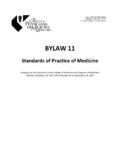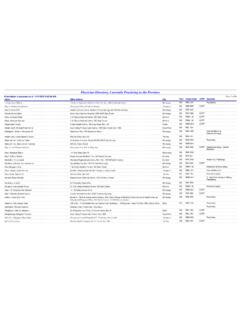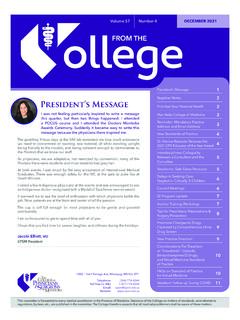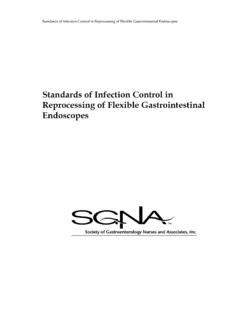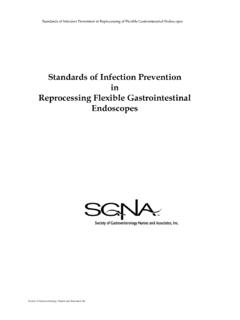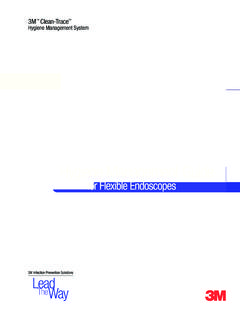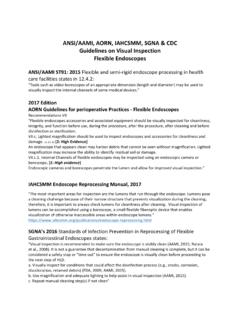Transcription of Guidelines for Infection Prevention and Control in …
1 COMMUNICABLE DISEASE CONTROLG uidelines for InfectionPrevention and Controlin EndoscopyEndoscopy Working GroupInfection Control SubcommitteeManitoba Advisory Committee on Infectious DiseasesSeptember 2000 ManitobaHealthPublic HealthGenevieve Thompson ChairDr. Michelle J. AlfaInfection Control /Occupational HealthMicrobiology LaboratoryMisericordia Health CentreSt. Boniface General HospitalYvette BuchananBrenda DyckInfection ControlInfection ControlGrace General HospitalHealth Sciences CentreNila MacFarlaneSylvia DolynchukInfection ControlPresident (SGNA) Society ofSt. Boniface General HospitalGastroenterology Nurses and Associates Chapter, EndoscopySt. Boniface General HospitaliThis document was prepared by the Endoscopy Working Group of the Infection Control Subcommittee of theManitoba Advisory Committee on Infectious Manitoba Advisory Committee on Infectious Diseases (MACID) approved this document on October 19, :Drawings provided by Nancy OlsenManuscript preparation by Diane ZimmeriiTable of ContentsIIntroduction1 IIGlossary of Terms2 III Recommendations for Safety of Personnel3IV Guidelines for the Reprocessing of Endoscopes41.
2 Inspection42. Cleaning43. Sterilization and Disinfection44 A. Recommended Methods/Agents54 B. Agents Not Recommended for Disinfection of Endoscopes65. Rinsing66. Drying67. Storage68. Automated Endoscope Reprocessors (AER)69. Special Considerations7 VRecommendations for Accessories7 Biopsy Forceps7 Water Bottle7 Other Accessories7VI Medical Equipment7 VII Recommendations for Environment7 General Cleaning7 Spills7 Waste8 Facility Design8 VIII Continuous Quality Improvement8IX Appendix One Bioburden Determination for Flexible Endoscopes9 XFigure One Olympus Colonoscope (Video)11XI Guidelines have been prepared to replace the Recommendations for the Management ofEndoscopes published by Manitoba Health in July1989, and are applicable to endoscope usage in endoscopes should be replacedbecause they are very difficult to clean and that cannot withstand the processesdescribed in these Guidelines because of age, designor damage should not be are a number of good consensus guidelines1, 2, 3now available, which discuss in detail infectiousagents that can be transmitted by endoscopy,appropriate procedures for cleaning, reprocessing,and discussion about disinfection issues and American Society for GastrointestinalEndoscopy (ASGE)
3 , the Society of GastroenterologyNurses and Associates (SGNA), the Association forProfessionals in Infection Control and Epidemiology(APIC), the Centers for Disease Control (CDC) andthe Food and Drug Administration (FDA) have allendorsed a 1996 position statement Reprocessing ofFlexible Gastrointestinal Endoscopes. 4In this publication, we have adapted the guidelinesdeveloped by the Canadian Society ofGastroenterology Nurses and Associates (CSGNA), Infection Control : Recommended Guidelines inEndoscopy Settings, thank the Societyfor giving us permission to use the endoscopes come into contact withmucous membranes and are considered semicriticalitems. High level disinfection between each patientuse is the current minimum reprocessing standard , 4, 5, 6, 7 Accessories such as re-usable biopsy forceps thatpenetrate mucosal barriers are classified as criticalitems and must be sterilized between each patientuse.
4 If these accessory items are labeled single-use,disposable they should not be reprocessed. Endoscopes that enter sterile body spaces ( ,arthroscopes, laparoscopes) should be sterilizedbefore each use. There are some references thatsuggest when sterilization is not feasible, endoscopesshould receive at least high-level , 21 Transmission of organisms from contaminatedbronchoscopes have illustrated problems associatedwith automated reprocessing models are not compatible withcertain automated reprocessing systems. Appropriateconnector systems, both device and model-specific,are have been implicated in the transmissionof disease when appropriate cleaning, disinfection orsterilization procedures were not , 9, 10 Ofparticular significance is the need to thoroughlymanually clean equipment prior toany manual orautomated disinfection or sterilization process.
5 1II Glossary of TermsAir:Airflow under pressure provided by a pump Endoscope Reprocessor (AER): Machines designed to assist with cleaning anddisinfecting of :70% isopropyl or ethyl :Visibly free from debris. Cleaning involves physicalremoval of blood, mucous, vomitus, fecal matter andother organic detergent:Low-sudsing enzymatic detergent formulationsrecommended for cleaning endoscopes. These arecombinations of detergent and enzymes capable ofdigesting organic material such as blood and mucouswithout damage to the Flexible:Flexible fiberoptic or video endoscopes used in theexamination of the hollow viscera (bronchoscope,colonoscope, duodenoscope, gastroscope,sigmoidoscope).
6 Endoscopes Rigid:Small straight scopes generally without lumens(arthroscope, laparoscope, cystoscope).High-level Disinfectant:A liquid chemical germicide capable of destroying allvegetative bacteria (including mycobacteria), virusesand fungi but not necessarily all bacterial disinfectants are registered with HealthCanada and/or the United States Federal DrugAdministration (FDA).Low-level Disinfectant/Cleaner:Destroys most vegetative bacteria, fungi and someviruses, but not mycobacteria or bacterial products are registered with Health Canadaand/or the United States Environment ProtectionAgency (EPA) similar to housekeeping products usedfor environmental :Killing all microorganisms, including Endoscope:An endoscope rendered clean after being subjected toa validated cleaning procedure, subjected tominimally a high-level disinfection process andrinsed so that it does not contain residual chemicalsin amounts that can be harmful to Practices.
7 11 Infection Control precautions that apply to allpatients regardless of their diagnosis or presumedinfection status. All patients and all body fluids,secretions and mucous membranes are consideredpotentially infectious. This was previously referred toas universal Cleaner:An instrument reprocessing unit that uses ultra-sound waves to produce tiny air bubbles in acleaning solution. The imploding of the air bubblesdislodges debris even in hard to reach areas Potable: Tap water that meets provincial regulations assuitable for Sterile:Water that has either been steam autoclaved or filtersterilized by passage through a micron Recommendations for Safety ofPersonnelSafety is of the utmost importance and should be inthe forefront of each employee s thinking.
8 Consistentpractice must be maintained to prevent the spread ofdisease and to protect from the dangers of chemicalsused in the cleaning and high-level disinfection ofendoscopes. Practices that should be followedinclude: All personnel should be immunized forHepatitis B. Bronchoscopy personnel should bemonitored by Occupational Health forexposure to tuberculosis as , 22 Health care workers who have respiratoryproblems ( , asthma, latex or chemicalallergies) should be assessed byOccupational Health prior to working inthe area. Irritation can be minimized with coveredcontainers and by using disinfectants in awell-ventilated area. Concentration ofglutaraldehyde fumes, if used, should neverexceed limits set by the Workplace Safety &Health Division, Manitoba Labour,200 401 York (945-3446).
9 Eye protection and moisture-resistantmasks or face shields should be worn toprevent contact with splashes during thecleaning procedure anddisinfection/sterilization process. Moisture-resistant gowns should be worn toprevent contamination of personnel due tosplashes of blood or other body fluids orinjury due to chemical disinfectant/sterilantcontact. Gowns should be changed betweenpatient procedures or when visibly soiled. Protective apparel ( , gowns and masks)should not be worn outside the procedureroom and cleaning room. Non-sterile gloves must be worn forhandling and cleaning dirty equipment, aswell as for any potential contact with bloodor body fluids. Gloves are recommendedwhen handling disinfectant solutions inorder to prevent caustic effects.
10 All needles and sharps are to beappropriately disposed of in puncture-resistant containers at their point of not recap needles. Fingernails should be kept short to preventthe puncturing of gloves. Jewellery shouldnot be worn on the hands because itharbors microorganisms, hindershandwashing and may puncture gloves. Meticulous hand washing with anappropriate antimicrobial agent must bedone between patient contact, after gloveremoval, and when entering or leaving theendoscopy area. If hands or other skinsurfaces are contaminated with blood orbody fluids, wash immediately. Health care workers who have exudativelesions or weeping dermatitis should refrainfrom all direct patient care and fromhandling patient care equipment until thecondition resolves.

